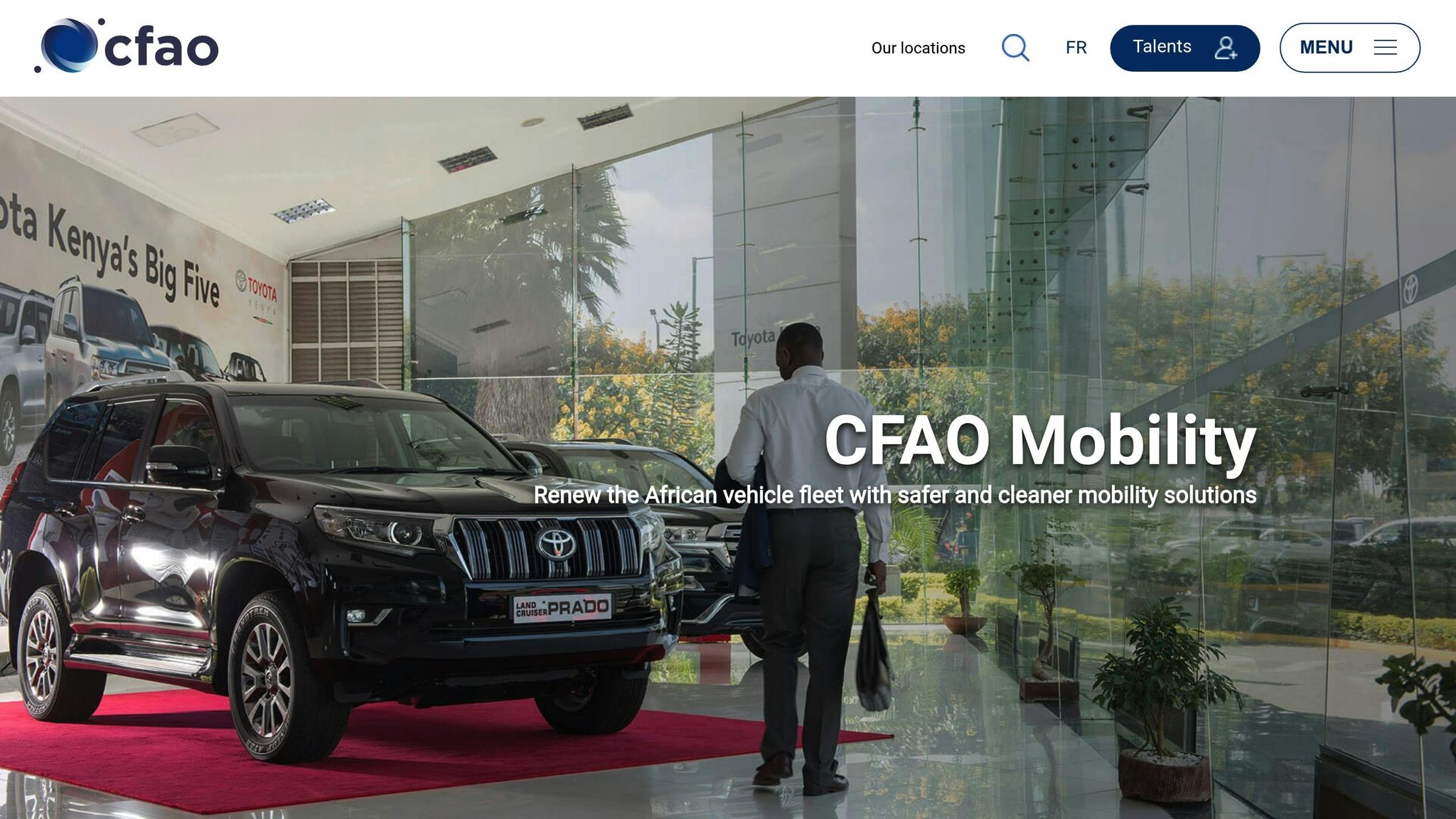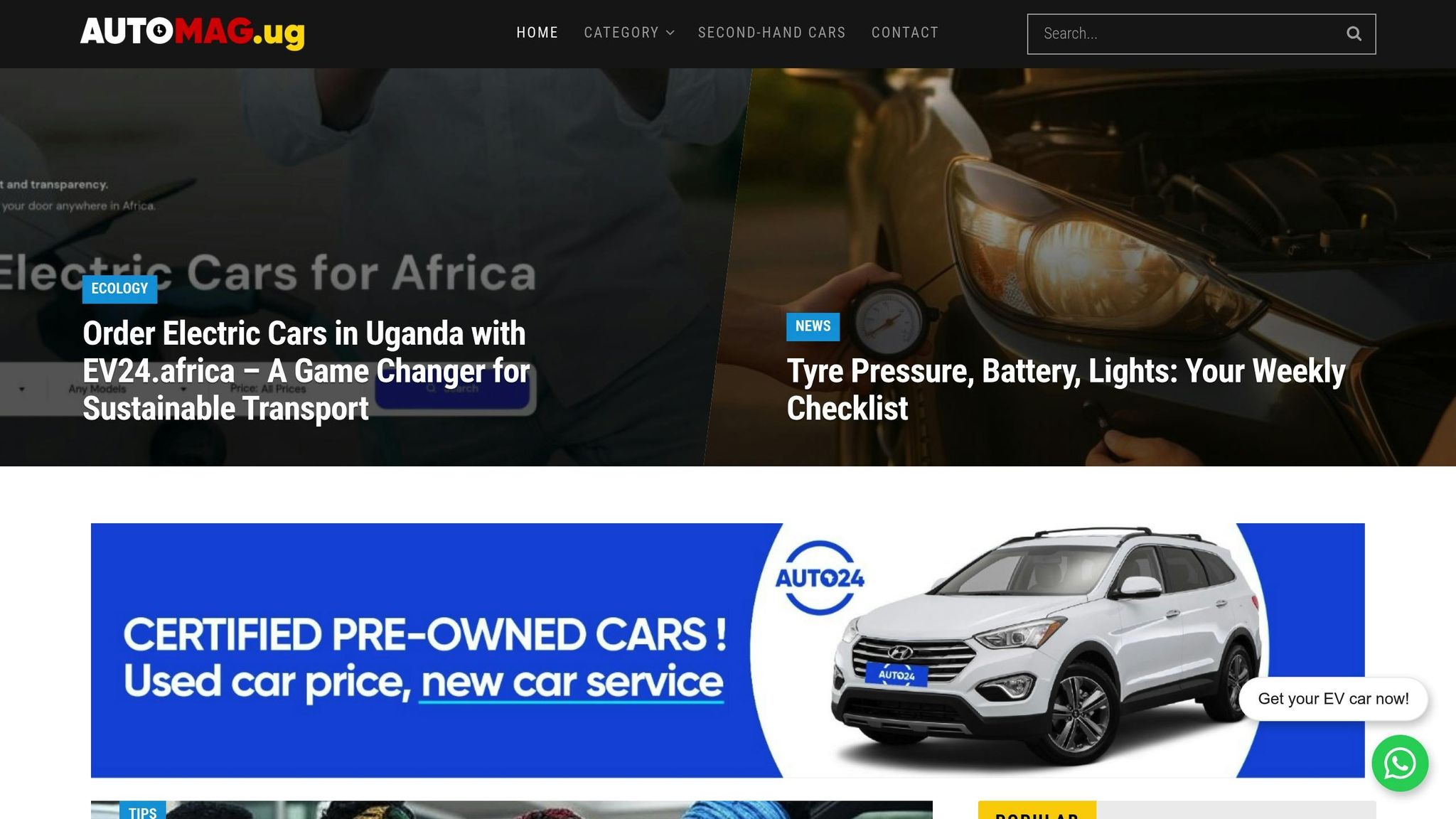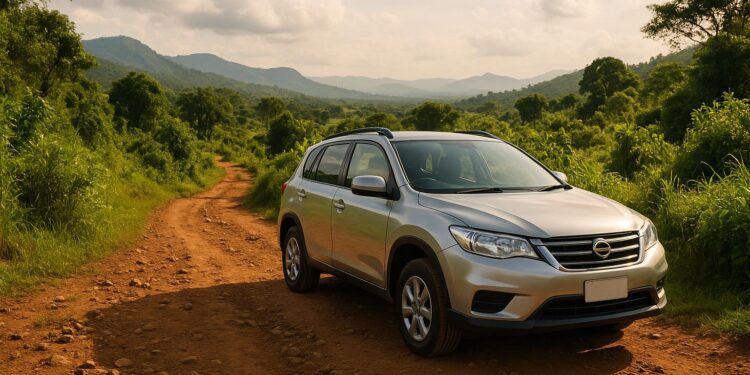Regular car maintenance isn’t optional in Uganda – it’s a must. The country’s tough roads, unpredictable weather, and heavy dust can quickly wear down your vehicle, even if it seems fine. Skipping maintenance leads to costly repairs, reduced fuel efficiency, and safety risks. Here’s what you need to know:
- Service more frequently: Uganda’s conditions demand shorter intervals than standard manufacturer recommendations. Oil changes every 2,500–3,100 miles and brake inspections every 12,000 miles are key.
- Focus on essentials: Prioritize oil changes, brake checks, tire care, and air filter replacements to prevent major issues.
- Uganda-specific challenges: Dust clogs air filters, potholes damage suspension, and the rainy season accelerates rust and brake wear.
- Choose trusted mechanics: Opt for certified technicians with transparent pricing and good reviews.
Investing in regular service saves money, improves safety, and extends your car’s life. Don’t wait for visible issues – Uganda’s roads demand proactive care.
Important checks done during vehicle service at CFAO Mobility in Uganda #toyotaug #cfao #service

When to Service Your Car: Recommended Intervals for Uganda
Car manufacturers usually provide service schedules designed for ideal conditions – smooth highways, mild climates, and consistent driving patterns. But in Uganda, where roads can be rough and weather unpredictable, these standard guidelines might not fully protect your car from wear and tear. To keep your vehicle running smoothly in Uganda’s challenging environment, it’s essential to adjust these intervals.
Standard Service Schedules
Under typical conditions, manufacturers recommend servicing your car every 3,100–6,200 miles (5,000–10,000 km) or every 6 months. This includes oil changes and tire rotations, which are generally advised every 6,200 miles (10,000 km). For transmission fluid flushes, the standard interval is around 24,850 miles (40,000 km). While these are solid starting points, they don’t consider Uganda’s unique driving challenges.
Why More Frequent Service Is Necessary in Uganda
Uganda’s road conditions demand extra care. Dusty environments clog air filters, and urban stop-and-go traffic puts added strain on engines and brakes, causing fluids to degrade faster. On top of that, extreme weather conditions can exacerbate wear and tear on your vehicle.
"Owning a car in Uganda is a significant investment, and proper maintenance is key to ensuring a long lifespan and avoiding expensive repairs." – David Okech
The cost of maintaining roads in Uganda, estimated at $5,700 per mile (approximately $9,165 per km) by the Uganda National Roads Authority, highlights how tough the terrain can be – not just on infrastructure but on your car as well.
Service Schedule Quick Reference
To keep your car in top shape amidst Uganda’s harsh conditions, consider these adjusted service intervals:
| Service Type | Standard Interval | Uganda Recommended | Key Tasks |
|---|---|---|---|
| Minor Service | Every 3,100 miles (5,000 km) | Every 2,500–3,100 miles (4,000–5,000 km) | Oil change, fluid level checks, tire pressure, basic inspection |
| Medium Service | Every 6,200 miles (10,000 km) | Every 4,350–5,600 miles (7,000–9,000 km) | Tire rotation, air filter replacement, brake inspection, battery check |
| Major Service | Every 12,400 miles (20,000 km) | Every 9,300–11,200 miles (15,000–18,000 km) | Comprehensive inspection, transmission service, cooling system flush |
These adjusted intervals are designed to combat the effects of dust, heat, and rugged roads. Additionally, simple tasks like frequent car washes and cleaning battery terminals can help prevent dust buildup and corrosion. If you often drive on unpaved or especially dusty roads, pay extra attention to components like air filters and suspension systems to avoid costly repairs down the line.
Key Maintenance Tasks and Why They Matter
Proper vehicle maintenance is crucial, especially when navigating Uganda’s tough driving conditions. Some tasks are more critical than others to ensure your car remains safe and dependable.
Regular Maintenance Tasks You Need
Oil and filter changes are a must. Clean oil keeps your engine parts moving smoothly and prevents wear. In Uganda’s dusty environment, air filters also take a beating and need frequent attention to maintain engine performance.
Brake system care is another priority. Brake pads should be inspected every 12,000 miles and replaced when they wear down to 3mm or less. Brake fluid, on the other hand, should be changed every 2 years or 24,000 miles to ensure the brakes function effectively. Uganda’s hilly terrain and heavy traffic put extra strain on your brakes, making this maintenance even more critical.
Tire maintenance involves keeping an eye on tire pressure, rotating them regularly, and checking for uneven wear. Proper tire inflation can improve fuel efficiency by up to 3%. Make it a habit to check tire pressure at every service visit, and rotate your tires every 6,200 miles (10,000 km) to ensure they wear evenly.
Battery and electrical system upkeep is especially important in Uganda’s climate. Regularly cleaning battery terminals prevents corrosion and prolongs battery life. It’s also essential to ensure your alternator is working properly. While most batteries last 2 to 4 years, neglect can shorten their lifespan significantly.
Cooling system checks are vital to avoid overheating. Routine coolant inspections and flushes protect your engine from damage, which is particularly important in Uganda’s hot weather.
Skipping these tasks can lead to costly problems and compromise your car’s safety.
Problems That Happen When You Skip Maintenance
Neglecting these essential tasks often leads to serious issues. For instance, skipping oil changes can cause oil to degrade into sludge, which damages the engine and could lead to failure – a repair that might set you back $4,000 or more.
"Regular auto maintenance is the lifeline of your vehicle…ignoring those maintenance tasks, such as tire rotation, brake pad replacement, or the essential car engine oil change, can lead to serious and costly issues down the road." – Boyd Motor Werks
Failing to maintain your brakes can be downright dangerous. Worn brake pads can damage the rotors, turning a simple pad replacement into an expensive overhaul. Worse, brake failure puts everyone on the road at risk.
Ignoring tire care can lead to uneven wear, blowouts, and poor handling – hazards that are even more pronounced on Uganda’s rough, unpaved roads. Bad tires also hurt fuel efficiency and increase the chances of accidents, especially during rainy seasons.
Clogged air filters are another problem, particularly in dusty areas. A dirty filter can reduce fuel efficiency by up to 10% and cut acceleration by 6–11%. This forces the engine to work harder, leading to higher fuel costs and faster wear.
The financial toll of neglecting maintenance is staggering. Skipping routine care contributes to over $2 billion in avoidable repairs annually. On average, repairs cost $0.42 per mile, compared to just $0.09 per mile for regular maintenance.
Maintenance Task Checklist
Here’s a quick summary of key tasks, how often to perform them, and what’s at stake if you don’t:
| Maintenance Task | Frequency | Benefit of Performing | Consequence of Skipping |
|---|---|---|---|
| Oil Change | Every 3,000–7,500 miles | Extends engine life, improves fuel efficiency | Engine damage, reduced efficiency; potential $4,000+ repair costs |
| Brake Check | Every 12,000 miles | Ensures safe stopping and prevents rotor damage | Brake failure, increased stopping distance, costly repairs |
| Tire Inspection | Every service visit | Improves handling, extends tire life, boosts fuel efficiency by up to 3% | Reduced traction, blowouts, poor fuel economy, safety risks |
| Air Filter Replacement | Per manufacturer’s guidance | Enhances acceleration and fuel efficiency | Reduced engine performance, higher fuel costs, premature wear |
| Battery Maintenance | Regular cleaning | Prevents corrosion, extends battery life | Electrical failures, shortened battery lifespan |
| Coolant System Check | Every major service | Prevents overheating, protects engine components | Overheating, expensive damage, potential engine failure |
sbb-itb-7bab64a
How Uganda’s Roads and Climate Affect Car Maintenance
Uganda’s roads and climate present unique challenges for vehicle maintenance. The combination of rough, dusty roads, heavy seasonal rains, and high temperatures puts extra strain on vehicles, making regular upkeep not just important but essential. Adapting your maintenance routine to these conditions can help keep your car in good shape and avoid costly repairs.
How Rough and Dusty Roads Impact Your Vehicle
Uganda’s road network is a mixed bag. While some highways are well-maintained, many secondary roads are unpaved, riddled with potholes, and generally unforgiving. These conditions can take a toll on your car, as one expert points out:
"Uganda’s roads can be unforgiving, with potholes and uneven terrain causing rapid tyre wear and damage to the suspension system."
Constant bumps and jolts from potholes wear out suspension components like shock absorbers and bushings. If you start hearing squeaking or knocking noises, it’s time for an inspection. Potholes can also damage tire sidewalls and cause uneven tread wear, especially if your tires are improperly inflated. Keeping your tires at the correct pressure and rotating them regularly can help extend their lifespan.
Dust is another major issue. It clogs air filters, reducing engine efficiency and potentially leading to overheating. Washing your car frequently can prevent dust and mud from corroding metal parts or clogging filters. For better durability, consider using all-terrain tires and avoid overloading your vehicle, as excess weight increases strain on the suspension.
Rain and Heat: Double Trouble for Your Car
Uganda’s seasonal weather brings its own set of challenges. During the rainy season, humidity accelerates rust formation, particularly on the undercarriage. Rain also impacts your brakes, as wet conditions reduce tire traction and can wash away lubrication in critical components like CV joints. Standing water and mud can further impair brake performance, making regular checks essential.
High temperatures, on the other hand, can wreak havoc on your car’s battery, tires, and cooling system. In fact, AAA reported over 2 million battery-related service calls during a single summer in the U.S., underscoring how heat accelerates battery wear. Tire pressure also fluctuates with temperature changes – rising by about one PSI for every 10°F increase – which can lead to overinflated tires and increase the risk of blowouts. Meanwhile, your engine cooling system has to work harder in the heat, making it crucial to monitor coolant levels and inspect the radiator for leaks.
Maintenance Tips for Uganda’s Conditions
Given Uganda’s tough driving conditions, some proactive measures can go a long way in keeping your car running smoothly:
- For rough and dusty roads: Stick to all-terrain or durable tires, ensure proper inflation, and avoid overloading your vehicle to reduce suspension strain. Wash your car regularly to clear away dust and mud that can damage filters and metal parts.
- For rainy seasons: Focus on rust prevention and electrical system checks. Inspect the undercarriage for rust, clean windows and windshields for better visibility, and replace worn windshield wipers. Bright, functioning headlights are critical for safety in heavy rain, as Nelson Xavier Ssenyange from Germax Autos explains:
"When the weather gets gloomy, and the downpour is steady, bright headlights are your rescue. Not only are they essential to help with visibility when it rains, but they also allow other drivers on the road to notice your vehicle, preventing accidents."
- For high temperatures: Monitor coolant levels, use high-quality engine oil, and check your radiator for leaks. Keep your battery terminals clean and secure, and have the battery tested before the hottest months. Check tire pressure when the tires are cool, and inspect the treads for heat-related wear. Parking in the shade or using sunshades can help protect your car’s interior and reduce strain on the cooling system.
Finally, scheduling regular inspections with a qualified mechanic is key. Catching issues like misalignment or worn parts early can save you from expensive repairs later and ensure your vehicle stays safe and reliable on Uganda’s demanding roads.
How to Choose a Good Service Center in Uganda
When driving in Uganda, where the roads and weather can be tough on vehicles, finding the right service center is crucial to keeping your car safe and reliable.
Finding Trusted Workshops and Authorized Centers
Look for service centers with certified technicians, such as those with Bosch certification, to ensure your car gets professional care. These technicians are trained to handle complex issues and deliver quality workmanship.
It’s also wise to choose centers equipped with advanced diagnostic tools, like Bosch systems, to identify problems early. For example, VAG Motors, a licensed Bosch franchisee, is known for its expertise and excellent customer service:
"At VAG Motors, we pride ourselves on offering top-quality automotive services at both our Shell Bukoto and Makindye branches. Our team of certified technicians is dedicated to keeping your vehicle in optimal condition, using state-of-the-art diagnostic equipment and genuine spare parts."
Comprehensive service options are another key factor. Centers that provide everything from diagnostics to routine maintenance help prevent small issues from turning into costly repairs. For instance, Shell operates over 150 Shell Service Bay outlets in Uganda, many of which include Express Bosch Car Service. These centers typically offer oil changes, brake maintenance, battery testing, wheel alignment, and genuine Bosch spare parts.
Transparency is a must. Choose workshops that provide clear explanations and detailed estimates before starting any repairs. Avoid those that push unnecessary services or fail to explain the work being done. As lubricant technician Jackson Mutaya from Total Kibuli advises:
"Look out for good car service points and opt for trusted mechanics."
Some mechanics go the extra mile to earn trust. For example, Auto mechanic Jamil Kibalya shares:
"I call my clients and give them updates on the progress of their cars. Many don’t trust mechanics, so I offer the option of working on their cars at their homes so they feel safer. This has really helped me improve my clientele relationships, and I am grateful for the various opportunities given to me."
Personal recommendations from friends, family, or other drivers can also be a great starting point. Testing a center with minor services before committing to major repairs is another smart approach. Don’t forget to check online reviews for additional insights.
Using AutoMag.ug for Maintenance Information

Once you’ve found a reliable service center, enhance your car care knowledge with AutoMag.ug. This platform offers maintenance tips specifically tailored to Uganda’s driving conditions, helping you understand when and why certain services are necessary. It also provides insights into popular car models, giving you a better grasp of your vehicle’s unique needs. With AutoMag.ug, you can make informed decisions to keep your car running smoothly in Uganda’s challenging environment.
Conclusion: Keep Your Car Running with Regular Service
Staying on top of regular car maintenance in Uganda isn’t just about keeping your vehicle in good shape – it’s also a smart financial decision. On average, routine servicing offers an impressive return on investment of 545%. Think about it: spending $120 a year on oil changes could save you from a $5,000 engine replacement down the road. Similarly, setting aside $200 every 50,000 miles for transmission fluid changes can help you avoid a $3,000 transmission rebuild. These numbers speak for themselves.
Uganda’s challenging driving conditions make routine maintenance even more crucial. Cars face extra stress, so regular oil changes, brake checks, and filter replacements aren’t just recommended – they’re essential to keep your vehicle running smoothly.
The benefits go beyond just avoiding breakdowns. Routine tune-ups can boost your car’s fuel efficiency by around 4%, which adds up to noticeable savings over time. Plus, avoiding emergency roadside assistance – which can cost anywhere from $350 to $700 – is another reason to stay proactive. In Uganda’s remote areas, a breakdown isn’t just inconvenient; it can pose serious safety risks and disrupt your plans.
Even if your car seems fine, Uganda’s roads and climate can cause wear and tear that isn’t immediately visible. Regular servicing helps catch these hidden issues early, ensuring repairs remain manageable and affordable.
FAQs
Why do cars in Uganda need servicing more often than in other countries?
Cars in Uganda often demand more frequent servicing, and it’s no surprise why. The country’s challenging road conditions – many of which are unpaved or poorly maintained – can take a toll on essential parts like tires, suspension systems, and brakes. The constant exposure to dust and debris doesn’t help either, as it can clog air filters and impact engine performance. Regular check-ups are a must to keep everything running smoothly.
Adding to the mix, a significant portion of vehicles in Uganda are older, second-hand imports. These cars often come with high mileage and may not align with modern maintenance standards. Without consistent upkeep, they can become less reliable and potentially unsafe. Staying on top of routine servicing not only avoids expensive repairs but also ensures your car is ready to handle Uganda’s unique and demanding driving conditions.
How do Uganda’s roads and climate impact car maintenance?
Uganda’s roads and climate present unique challenges for maintaining your car. The combination of high temperatures, heavy rainfall, and dusty conditions accelerates wear on key parts like brakes, tires, and the engine. Add uneven terrain and poor road infrastructure into the mix, and you’re looking at frequent suspension and alignment issues as well.
This makes routine servicing a must if you want to avoid expensive repairs and keep your vehicle running safely. Simple steps like checking tire pressure, inspecting brakes, and keeping an eye on engine performance can go a long way in countering the impact of Uganda’s demanding driving conditions.
How do I find a trustworthy service center in Uganda for my car’s maintenance?
To locate a dependable service center in Uganda, start by checking out garages with skilled, certified technicians who have a strong track record for delivering quality work. Opt for centers equipped with modern diagnostic tools – these are essential for accurate evaluations and effective maintenance. If possible, choose a garage that specializes in your car’s brand, as they’re more likely to have the right expertise and access to genuine parts.
You can also ask friends or family for recommendations and read online reviews to gauge the quality of service. Focus on service centers that offer clear pricing, excellent customer support, and prioritize safety and reliability. Sticking to regular maintenance at a trusted garage not only keeps your vehicle in top shape but also helps you avoid expensive repairs in the future.
Related posts
- 8 Essential Car Maintenance Tips for Uganda’s Climate
- Common Car Problems in Uganda: Solutions Guide
- How to Save Money on Used Car Maintenance
- Car maintenance costs in Uganda




